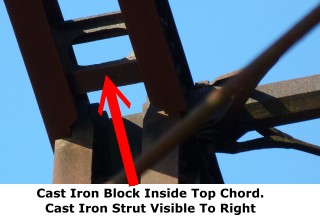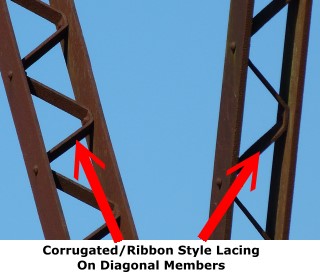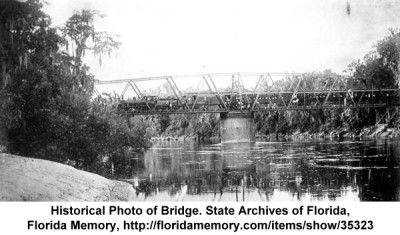We Recommend:
Bach Steel - Experts at historic truss bridge restoration.
Drew Bridge

Primary Photographer(s): Nathan Holth
Bridge Documented: November 16, 2014
Railroad (Abandoned Suwannee and San Pedro) Over Suwannee River
Rural: Lafayette County, Florida and Suwannee County, Florida: United States
By Builder/Contractor: Unknown
1901
260.0 Feet (79.2 Meters)
Not Available
13 Feet (3.96 Meters)
1 Main Span(s)
Not Applicable

View Information About HSR Ratings
Bridge Documentation
2023 Update: Good news: local residents informed HistoricBridges.org that this bridge survived intact following Hurricane Idalia
Bridge Overview
This railroad bridge was reportedly moved here from Brazil and put into service at this location around 1901, and abandoned in 1920. Its original construction date is unknown, but it displays cast iron elements and unusual details that are characteristic of early metal truss bridges. As such, this bridge is presumed to be one of the oldest surviving swing bridges in the country, if not the oldest. Its assumed age, unusual design, rare use of cast iron beams, and lack of alteration to the trusses, place it among the most significant historic truss bridges in the country.
A kayak rental from the nearby Suwannee River Rendezvous was utilized to access and photograph this bridge, and is recommended for anyone visiting the bridge who wants a closer look at the bridge, plus the river itself is very scenic.
History of the Bridge
The bridge and the railroad it served has connections to Florida's governor (from 1877-1881) George Franklin Drew and his sons George L. Drew and Franklin Drew. George Franklin Drew also created a logging company called the Drew Lumber Company, which was operated along with his son George L. Drew. In 1899, the lumber company found need for a railroad to haul their materials, and they ended up buying the Suwannee and San Pedro Railroad, and extended it so that it would cross the Suwannee River. They took over the railroad's charter in July 1, 1899 and only 20 days later amended it to extend the link to places like Mayo, FL. This new, extended route needed a Suwannee River bridge. George L. Drew died in September 27, 1900, and Franklin Drew and George L. Drew took the lead in the railroad endeavor as a result. They had purchased a bridge for $15,500, which reportedly came from Brazil, which was barged into this location to serve their new section of railroad line. Reportedly, the eastern approach grading work was completed by May 8, 1901. It is thus assumed the bridge was installed around this time. The Suwannee and San Pedro Railroad was merged with some other railroad companies into the Florida Railway in 1905. The railway did not last, partially due to completion from other railroads, and from 1918-1921 the railroad was dismantled. The bridge however was not scrapped out, and instead in 1920, Suwannee and Lafayette Counties purchased the bridge for potential use as a highway bridge. This apparently never panned out, and the bridge has remained standing abandoned in the open position to this day.
Note, the source for most of this information was from taplines.net and this post on Flickr.
Today, the bridge is missing a deck, and no easily visible portions of the abutments or any approach spans remain.
Bridge Description Focusing on Unusual Details

The bridge is symmetrical rim-bearing swing span, and the truss superstructure is a pin-connected Warren through truss. Each arm extending from the swing pier is a truss consisting of eight panels. The bridge was an hand-turned swing bridge.
This bridge contains a unique, non-standard design, characteristic of bridges built in the earlier decades of metal truss bridge construction, when a greater level of invention and experimentation was practiced. A few of the most notable unusual details are outlined below.
The portal bracing for the bridge is composed of an i-beam at the top, with angle and plate used to form curved knee braces which forms an arch-like shape for the portal of the bridge. Elsewhere between the top chord, there are cast iron beams acting as struts (sway bracing). One exception to this is at the swing pier where a more extensive sway bracing system is found which is similar to but more extensive than the portal bracing, which includes two i-beams, and three sections of curved plate and angle on each side. Visually, these curved plates and angles form an oval shape between the i-beams, plus an arched shape below. Cast iron beams of the same design as the struts between the top chords can be found on the bottom chord at each panel point. Typically floor beams would be found here, but this bridge appears to have been designed so that the wooden deck would bear directly on the bottom chord, and so traditional floor beams were not used, and these cast iron beams provide the structural stability normally provided for by floor beams on most truss bridges.

The top chord of the bridge is composed of up-set eye bars near the swing pier, and at the ends, it is an unusual design composed of pairs of i-beams with cast iron block spacers. The bottom chord also has this unusual i-beams with cast iron block spacers design.
Lateral bracing is very unusual: some of the bracing is composed of rods that fork out at the ends to form two eye bars, which rest above and below the cast iron struts, with a pin passing through the two eyes and a hole in the cast iron strut. At the panels on the bottom chord where diagonal members are present, the lateral bracing is instead fastened via a threaded rod with nut to a casting along the bottom chord. At the top chord and end post connection, the lateral bracing is tied into the main pin.

The vertical members make an unusual connections. At a typical vertical, there are two eye bars and a single rod in the center. The center rod is connection to the top chord by what appears to be a u-bolt. The two outer eye bars connect to the top chord around the main pin. At the bottom chord, all three elements terminate as threaded rod, and they pass through holes in a cast iron spacer, and connect by passing between two short channels that are attached to the bottom chord and are bolted in place with nuts resting against plates spanning between the channels.
Many of the diagonals include an uncommon feature of corrugated (ribbon) style lacing.
At the swing pier the bottom chord rests on a circular i-beam, which in turn rests on the rollers. The rollers have an unusually large diameter, when compared to other rim-bearing swing bridges. The main circular rack of the bridge is of traditional design and rests on an unusual cast iron rim base. It is composed of segments of curved castings which are bolted together to form a complete circle.
The gearing for the bridge is partially intact. The large gears remain in place, but there is one missing pinion gear. The bridge appears to have been designed so that there were two pinions to engage the rack, perhaps so two people together could have turned the bridge.
The bridge pier is a large riveted caisson with concrete fill inside.
The rolled iron on the bridge displays the brand "Wadsworth Buffalo NY." This company was a name used for only a few years and before and after was known as Union Iron Company (or works). Information is hard to come by, but initial research suggests the Wadsworth name was in use from around 1869 to 1871, and that in the custom of rolling mills, the rollers containing the name likely were not discarded when the name change occurred, suggesting that even a year or two after Wadsworth switched back to the Union name, iron rolled in the mill might still have said Wadsworth on it. This would suggest the bridge was built anywhere from roughly 1869 to 1874.

Historic and Structural Integrity
The swing span trusses retain excellent historic and structural integrity. The approach spans, whatever form they may have taken, are gone, but the main swing span remains abandoned in the open position. The deck is completely missing, but the historically significant aspect of the bridge, the metal truss swing span, remains in excellent condition, and without notable alteration. The corrosion resistant wrought and cast iron has weathered time nicely. The swing pier is another story. The bottom of the pier near the water is deteriorated. The steel casing is completely missing in some areas, revealing the concrete within, which appears to be spalling. The other problem noted is with the rollers of the bridge. They appear to be leaning outward such that the truss is no longer bearing properly on many of them.
Oldest Surviving Swing Bridges in the United States

Information is not easy to come by for railroad bridges nationwide, since most are privately owned and not inventoried by either the National Bridge Inventory or a Historic Bridge Inventory. However, the Drew Bridge is believed to be a candidate for oldest surviving railroad swing bridge in the country, and perhaps even the oldest known surviving swing bridge among both highway and railroad bridges. Another possible contender for oldest railway swing bridge is the Redstone Bridge in Minnesota, dated to 1880. The oldest known highway swing bridge is the New Richmond Bridge in Michigan, dated to 1879.
The Drew Bridge was purchased around 1899-1901, and as such it is not hard to imagine that the bridge would have been at least 20 years old at that time, which is further supported by the design details of the bridge. It seems logical to suggest that the Drew Bridge dates to 1880 or earlier.

![]()
Photo Galleries and Videos: Drew Bridge
Bridge Photo-Documentation
Original / Full Size PhotosA collection of overview and detail photos. This gallery offers photos in the highest available resolution and file size in a touch-friendly popup viewer.
Alternatively, Browse Without Using Viewer
![]()
Bridge Photo-Documentation
Mobile Optimized PhotosA collection of overview and detail photos. This gallery features data-friendly, fast-loading photos in a touch-friendly popup viewer.
Alternatively, Browse Without Using Viewer
![]()
Maps and Links: Drew Bridge
Coordinates (Latitude, Longitude):
Search For Additional Bridge Listings:
Bridgehunter.com: View listed bridges within 0.5 miles (0.8 kilometers) of this bridge.
Bridgehunter.com: View listed bridges within 10 miles (16 kilometers) of this bridge.
Additional Maps:
Google Streetview (If Available)
GeoHack (Additional Links and Coordinates)
Apple Maps (Via DuckDuckGo Search)
Apple Maps (Apple devices only)
Android: Open Location In Your Map or GPS App
Flickr Gallery (Find Nearby Photos)
Wikimedia Commons (Find Nearby Photos)
Directions Via Sygic For Android
Directions Via Sygic For iOS and Android Dolphin Browser
USGS National Map (United States Only)
Historical USGS Topo Maps (United States Only)
Historic Aerials (United States Only)
CalTopo Maps (United States Only)






